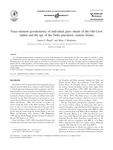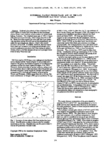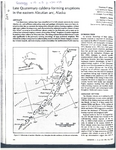Old Crow Tephra
Start: 202000 yBP ± 9500 Years [1]
Event Type: Explosive
Max VEI: 7 [2]
- Caldera/crater [10]
Description: From Burgess and others (2019): "The source of the Old Crow tephra is often attributed to the ELVC, which contains rocks of similar age and geochemical (Type 1) composition (Preece et al., 1999; Waythomas et al., 2001). Dissimilarity of Fe-Ti oxide compositions between the Old Crow and ELVC caldera-forming eruptions and smaller-volume lavas suggests that ELVC is not the source of the Old Crow tephra. This compositional difference is highlighted by relatively elevated MgO for Old Crow titanomagnetites relative to ELVC rocks. Old Crow titanomagnetite chemistry is characterized by significantly lower TiO2 contents than both the ~240 ka Cathedral welded tuff, whose 40Ar/39Ar date is consistent with the 206Pb/238U dates from Old Crow zircons, as well as the ~125 ka Gap welded tuff whose 40Ar/39Ar age overlaps within uncertainty with the Old Crow fission track date (125 ± 20 ka). The results of this study indicate that the Old Crow source must be characterized by, (1) Type 1 glass composition (Preece et al., 1999), (2) low TiO and high MgO titanomagnetite composition, and (3) age-appropriate and voluminous (>200 km3) eruptions capable of generating regionally extensive tephra. The observed lack of Old Crow tephra within the IODP cores from the shelf of the Gulf of Alaska may indicate that regardless of source volcano, the tephra did not travel appreciably south upon eruption. Instead, its path was predominately northeast, as is indicated by existing distribution
maps (Preece et al., 2011a)." "Our 206Pb/238U, 230Th/238U, and (UeTh)/He geochronology indicates a final crystallization/cooling age of 202.9 ± 9.5 ka for zircon in the Old Crow tephra, and in turn a similar eruption age, and an Aleutian source for the tephra other than the Emmons Lake Volcanic Center. The possibility of Old Crow eruption within the MIS 7 interglacial period represents a marked difference from the commonly cited eruption age, and disagrees with existing chronologies for Pleistocene stratigraphy of eastern Beringia. We acknowledge the disruptive implications of an MIS 7 eruption age for the Old Crow tephra. However, the concordance of both zircon crystallization and cooling ages and the paucity of zircons younger than ~200 ka strongly suggest that the youngest population of Old Crow zircons represent the timing of volcanic eruption." From Preece and others (2011): "Old Crow tephra is the largest and most widespread Quaternary eruption presently known in eastern Beringia. Its major- and trace-element geochemistry, Fe-Ti oxides, and stratigraphic and paleoecological context indicate that it is the result of a single cataclysmic eruption. The proximal region may well have experienced tephra fallout from small eruptions just prior to or after the Old Crow event, but there is no evidence to indicate that the distal area was affected. We recalculate the glass fission-track age at 124+/-10 ka, which, coupled with stratigraphic and paleoenvironmental reconstructions, indicates that deposition occurred prior to development of the last interglacial boreal forest, which suggests a latest Marine Isotope Stage (MIS) 6 age. The bulk tephra volume erupted is estimated by three different approaches, that are in broad agreement at ~200 km 3, but this result must be considered as tentative given the poor controls on definition of isopachs over such a large area. The source caldera, although presently unrecognized, is located in the eastern Aleutian arc, possibly at or near the Emmons Lake volcanic center."
"Old Crow tephra is interbedded within fluvial deposits at its type locality at Ch’ijee’s Bluff along the Porcupine River near Old Crow in northern Yukon and at two sites on the Noatak River (Fig.1, Table 1, sites 26, 7 and 8, respectively [in original text]). It is closely associated with glacial deposits at site 1 in SW Alaska and sites 23 and 24 in SW Yukon. Host sediments at Imruk Lake (site 5) and Koyukuk (site 10) are of lacustrine origin, whereas in the Old Crow Basin (sites 26, 27) OCt occurs in both fluvial and lacustrine sediments. Old Crow tephra has been found in pond deposits within a loess unit on the Baldwin Peninsula (site 6) and in glaciotectonized marine sediments at Hagemeister Island and Togiak Bay, SWAlaska (sites 2, 3). Aeolian sands form the host sediments at Holitna (site 4) and the Richardson Highway site 20. At all other localities, OCt is associated with loess or reworked loess (Table 1 [in original text])"
The Global database on large magnitude explosive volcanic eruptions (LaMEVE; 2017) reports a magnitude of 7.5, bulk eruptive volume of 50 cubic km and a dense rock equivalent eruptive volume of 20 cubic km for the eruption.
maps (Preece et al., 2011a)." "Our 206Pb/238U, 230Th/238U, and (UeTh)/He geochronology indicates a final crystallization/cooling age of 202.9 ± 9.5 ka for zircon in the Old Crow tephra, and in turn a similar eruption age, and an Aleutian source for the tephra other than the Emmons Lake Volcanic Center. The possibility of Old Crow eruption within the MIS 7 interglacial period represents a marked difference from the commonly cited eruption age, and disagrees with existing chronologies for Pleistocene stratigraphy of eastern Beringia. We acknowledge the disruptive implications of an MIS 7 eruption age for the Old Crow tephra. However, the concordance of both zircon crystallization and cooling ages and the paucity of zircons younger than ~200 ka strongly suggest that the youngest population of Old Crow zircons represent the timing of volcanic eruption." From Preece and others (2011): "Old Crow tephra is the largest and most widespread Quaternary eruption presently known in eastern Beringia. Its major- and trace-element geochemistry, Fe-Ti oxides, and stratigraphic and paleoecological context indicate that it is the result of a single cataclysmic eruption. The proximal region may well have experienced tephra fallout from small eruptions just prior to or after the Old Crow event, but there is no evidence to indicate that the distal area was affected. We recalculate the glass fission-track age at 124+/-10 ka, which, coupled with stratigraphic and paleoenvironmental reconstructions, indicates that deposition occurred prior to development of the last interglacial boreal forest, which suggests a latest Marine Isotope Stage (MIS) 6 age. The bulk tephra volume erupted is estimated by three different approaches, that are in broad agreement at ~200 km 3, but this result must be considered as tentative given the poor controls on definition of isopachs over such a large area. The source caldera, although presently unrecognized, is located in the eastern Aleutian arc, possibly at or near the Emmons Lake volcanic center."
"Old Crow tephra is interbedded within fluvial deposits at its type locality at Ch’ijee’s Bluff along the Porcupine River near Old Crow in northern Yukon and at two sites on the Noatak River (Fig.1, Table 1, sites 26, 7 and 8, respectively [in original text]). It is closely associated with glacial deposits at site 1 in SW Alaska and sites 23 and 24 in SW Yukon. Host sediments at Imruk Lake (site 5) and Koyukuk (site 10) are of lacustrine origin, whereas in the Old Crow Basin (sites 26, 27) OCt occurs in both fluvial and lacustrine sediments. Old Crow tephra has been found in pond deposits within a loess unit on the Baldwin Peninsula (site 6) and in glaciotectonized marine sediments at Hagemeister Island and Togiak Bay, SWAlaska (sites 2, 3). Aeolian sands form the host sediments at Holitna (site 4) and the Richardson Highway site 20. At all other localities, OCt is associated with loess or reworked loess (Table 1 [in original text])"
The Global database on large magnitude explosive volcanic eruptions (LaMEVE; 2017) reports a magnitude of 7.5, bulk eruptive volume of 50 cubic km and a dense rock equivalent eruptive volume of 20 cubic km for the eruption.
References Cited
[1] On the eruption age and provenance of the Old Crow tephra, 2019
Burgess, S.D., Coble, M.A., Vazquez, J.A., Coombs, M.L., and Wallace, K.L., 2019, On the eruption age and provenance of the Old Crow tephra: Quaternary Science Reviews, v. 207, p. 64-79. https://doi.org/10.1016/j.quascirev.2018.12.026[2] Volcanoes of the World, 2013
Global Volcanism Program, 2013, Volcanoes of the World, v. 4.5.3. Venzke, E (ed.): Smithsonian Institution. Downloaded 2017. http://dx.doi.org/10.5479/si.GVP.VOTW4-2013[3] Old Crow Tephra found at the Palisades of the Yukon, Alaska, 1991
Beget, J. E., Edwards, Mary, Hopkins, David, Keskinen, Mary, and Kukla, G. J., 1991, Old Crow Tephra found at the Palisades of the Yukon, Alaska: Quaternary Research, v. 35, n. 2, p. 291-297.[4] Late Pliocene Dawson Cut forest bed and new tephrochronological findings in the Gold Hill Loess, east-central Alaska, 2009
Pewe, T.L., Westgate, J.A., Preece, S.J., Brown, P.M., and Leavitt, S.W., 2009, Late Pliocene Dawson Cut forest bed and new tephrochronological findings in the Gold Hill Loess, east-central Alaska: Geological Society of America Bulletin, v. 121, n. 1-2, p. 294-320, doi: 10.1130/B26323.1 .[5] Old Crow tephra across eastern Beringia: a single cataclysmic eruption at the close of Marine Isotope Stage 6, 2011
Preece, S.J., Pearce, N.J.G., Westgate, J.A., Froese, D.G., Jensen, B.J.L., and Perkins, W.T., 2011, Old Crow tephra across eastern Beringia: a single cataclysmic eruption at the close of Marine Isotope Stage 6: Quaternary Science Reviews, v. 30, p. 2069-2099, doi:10.1016/j.quascirev.2010.04.020 .[6] A late-Middle Pleistocene (Marine Isotope Stage 6) vegetated surface buried by Old Crow tephra at the Palisades, interior Alaska, 2010
Reyes, A.V., Jensen, B.L., Zazula, G.D., Ager, T.A., Kuzmina, Svetlana, La Farge, Catherine, and Froese, D.G., 2010, A late-Middle Pleistocene (Marine Isotope Stage 6) vegetated surface buried by Old Crow tephra at the Palisades, interior Alaska: Quaternary Science Reviews, v. 29, n. 5-6, p. 801-811, doi:10.1016/j.quascirev.2009.12.003[7] Isothermal plateau fission-track age of the late Pleistocene Old Crow Tephra, Alaska, 1988
Westgate, John, 1988, Isothermal plateau fission-track age of the late Pleistocene Old Crow Tephra, Alaska: Geophysical Research Letters, v. 15, n. 4, p. 376-379.[8] Distribution, stratigraphy, petrochemistry and palaeomagnetism of the late Pleistocene Old Crow tephra in Alaska and the Yukon, 1985
Westgate, J. A., Walter, R. C., Pearce, G. W., and Gorton, M. P., 1985, Distribution, stratigraphy, petrochemistry and palaeomagnetism of the late Pleistocene Old Crow tephra in Alaska and the Yukon: Canadian Journal of Earth Sciences [Journal Canadien des Sciences de la Terre], v. 22, n. 6, p. 893-906.[9] Old Crow tephra: a new late Pleistocene stratigraphic marker across North-central Alaska and western Yukon Territory, 1983
Westgate, J. A., Hamilton, T. D., and Gorton, M. P., 1983, Old Crow tephra: a new late Pleistocene stratigraphic marker across North-central Alaska and western Yukon Territory: Quaternary Research, v. 19, n. 1, p. 38-54.[10] Late Quaternary caldera-forming eruptions in the eastern Aleutian arc, Alaska, 1987
Miller, T. P., and Smith, R. L., 1987, Late Quaternary caldera-forming eruptions in the eastern Aleutian arc, Alaska: Geology, v. 15, n. 5, p. 434-438.Complete Eruption References
On the eruption age and provenance of the Old Crow tephra, 2019
Burgess, S.D., Coble, M.A., Vazquez, J.A., Coombs, M.L., and Wallace, K.L., 2019, On the eruption age and provenance of the Old Crow tephra: Quaternary Science Reviews, v. 207, p. 64-79. https://doi.org/10.1016/j.quascirev.2018.12.026
Old Crow tephra across eastern Beringia: a single cataclysmic eruption at the close of Marine Isotope Stage 6, 2011
Preece, S.J., Pearce, N.J.G., Westgate, J.A., Froese, D.G., Jensen, B.J.L., and Perkins, W.T., 2011, Old Crow tephra across eastern Beringia: a single cataclysmic eruption at the close of Marine Isotope Stage 6: Quaternary Science Reviews, v. 30, p. 2069-2099, doi:10.1016/j.quascirev.2010.04.020 .

A late-Middle Pleistocene (Marine Isotope Stage 6) vegetated surface buried by Old Crow tephra at the Palisades, interior Alaska, 2010
Reyes, A.V., Jensen, B.L., Zazula, G.D., Ager, T.A., Kuzmina, Svetlana, La Farge, Catherine, and Froese, D.G., 2010, A late-Middle Pleistocene (Marine Isotope Stage 6) vegetated surface buried by Old Crow tephra at the Palisades, interior Alaska: Quaternary Science Reviews, v. 29, n. 5-6, p. 801-811, doi:10.1016/j.quascirev.2009.12.003

Trace-element geochemistry of individual glass shards of the Old Crow Tephra and the age of the Delta glaciation, central Alaska, 2003
Beget, J. E., and Keskinen, M. J., 2003, Trace-element geochemistry of individual glass shards of the Old Crow Tephra and the age of the Delta glaciation, central Alaska: in Westgate, J. A., (ed.), Special issue dedicated to Troy Pewe, Quaternary Research, v. 60, n. 1, p. 63-69.

Isothermal plateau fission-track age of the late Pleistocene Old Crow Tephra, Alaska, 1988
Westgate, John, 1988, Isothermal plateau fission-track age of the late Pleistocene Old Crow Tephra, Alaska: Geophysical Research Letters, v. 15, n. 4, p. 376-379.

Late Quaternary caldera-forming eruptions in the eastern Aleutian arc, Alaska, 1987
Miller, T. P., and Smith, R. L., 1987, Late Quaternary caldera-forming eruptions in the eastern Aleutian arc, Alaska: Geology, v. 15, n. 5, p. 434-438.

Distribution, stratigraphy, petrochemistry and palaeomagnetism of the late Pleistocene Old Crow tephra in Alaska and the Yukon, 1985
Westgate, J. A., Walter, R. C., Pearce, G. W., and Gorton, M. P., 1985, Distribution, stratigraphy, petrochemistry and palaeomagnetism of the late Pleistocene Old Crow tephra in Alaska and the Yukon: Canadian Journal of Earth Sciences [Journal Canadien des Sciences de la Terre], v. 22, n. 6, p. 893-906.

Old Crow tephra: a new late Pleistocene stratigraphic marker across North-central Alaska and western Yukon Territory, 1983
Westgate, J. A., Hamilton, T. D., and Gorton, M. P., 1983, Old Crow tephra: a new late Pleistocene stratigraphic marker across North-central Alaska and western Yukon Territory: Quaternary Research, v. 19, n. 1, p. 38-54.
